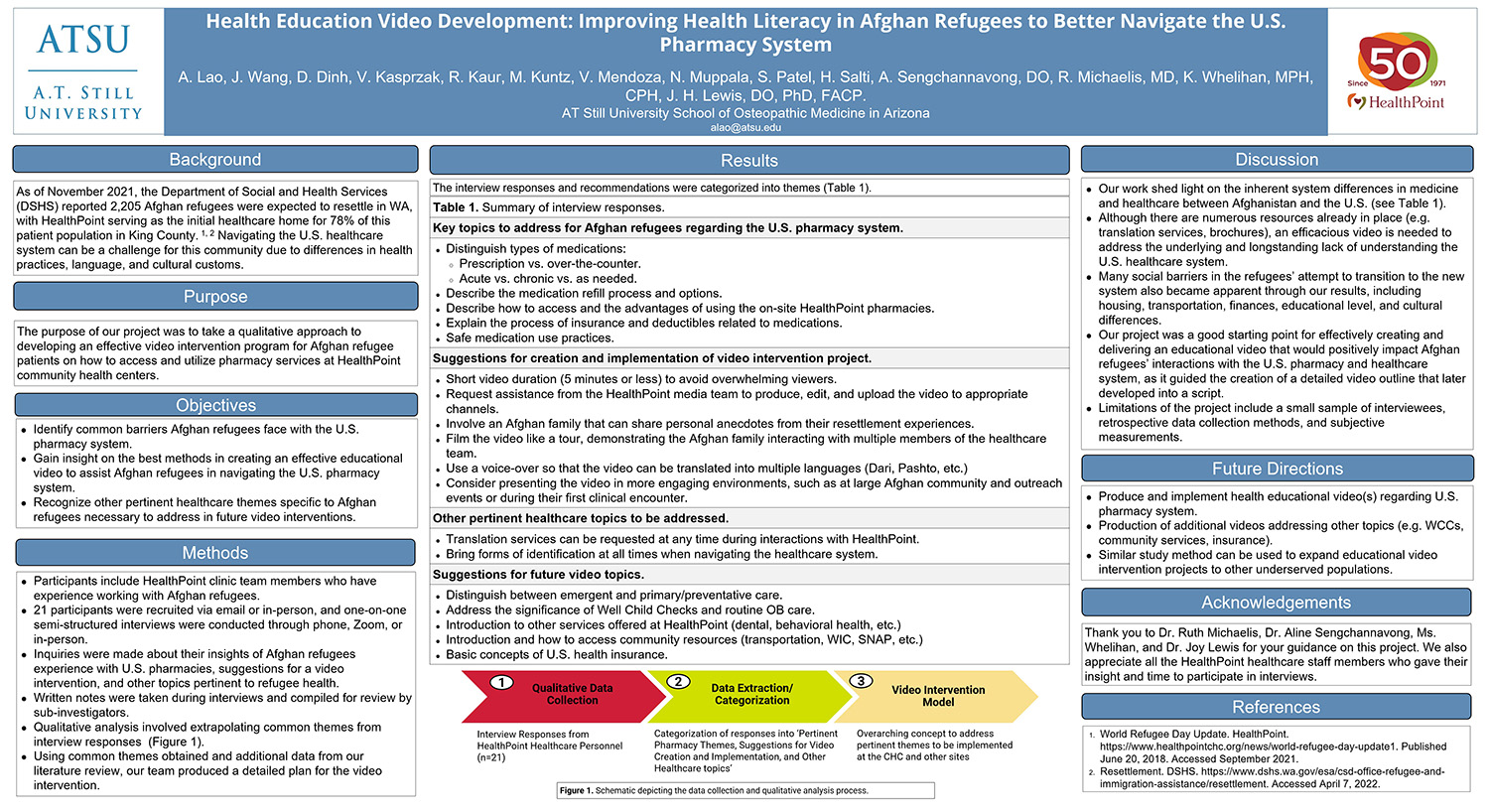A. Lao, J. Wang, D. Dinh, V. Kasprzak, R. Kaur, M. Kuntz, V. Mendoza, N. Muppala, S. Patel, H. Salti, A. Sengchannavong, DO, R. Michaelis, MD, K. Whelihan, MPH, CPH, J. H. Lewis, DO, PhD, FACP
Background
As of November 2021, the Department of Social and Health Services (DSHS) reported 2,205 Afghan refugees were expected to resettle in WA, with HealthPoint serving as the initial healthcare home for 78% of this patient population in King County. 1, 2 Navigating the U.S. healthcare system can be a challenge for this community due to differences in health practices, language, and cultural customs.
Purpose
The purpose of our project was to take a qualitative approach to developing an effective video intervention program for Afghan refugee patients on how to access and utilize pharmacy services at HealthPoint community health centers.
Objectives
- Identify common barriers Afghan refugees face with the U.S. pharmacy system.
- Gain insight on the best methods in creating an effective educational video to assist Afghan refugees in navigating the U.S. pharmacy system.
- Recognize other pertinent healthcare themes specific to Afghan refugees necessary to address in future video interventions.
Methods
- Participants include HealthPoint clinic team members who have experience working with Afghan refugees.
- 21 participants were recruited via email or in-person, and one-on-one semi-structured interviews were conducted through phone, Zoom, or in-person.
- Inquiries were made about their insights of Afghan refugees experience with U.S. pharmacies, suggestions for a video intervention, and other topics pertinent to refugee health.
- Written notes were taken during interviews and compiled for review by sub-investigators.
- Qualitative analysis involved extrapolating common themes from interview responses (Figure 1).
- Using common themes obtained and additional data from our literature review, our team produced a detailed plan for the video intervention.
Discussion
- Our work shed light on the inherent system differences in medicine and healthcare between Afghanistan and the U.S. (see Table 1).
- Although there are numerous resources already in place (e.g. translation services, brochures), an efficacious video is needed to address the underlying and longstanding lack of understanding the U.S. healthcare system.
- Many social barriers in the refugees’ attempt to transition to the new system also became apparent through our results, including housing, transportation, finances, educational level, and cultural differences.
- Our project was a good starting point for effectively creating and delivering an educational video that would positively impact Afghan refugees’ interactions with the U.S. pharmacy and healthcare system, as it guided the creation of a detailed video outline that later developed into a script.
- Limitations of the project include a small sample of interviewees, retrospective data collection methods, and subjective measurements.
Future Directions
- Produce and implement health educational video(s) regarding U.S. pharmacy system.
- Production of additional videos addressing other topics (e.g. WCCs, community services, insurance).
- Similar study method can be used to expand educational video intervention projects to other underserved populations.
Acknowledgements
Thank you to Dr. Ruth Michaelis, Dr. Aline Sengchannavong, Ms. Whelihan, and Dr. Joy Lewis for your guidance on this project. We also appreciate all the HealthPoint healthcare staff members who gave their insight and time to participate in interviews.
References
- World Refugee Day Update. HealthPoint. https://www.healthpointchc.org.... Published June 20, 2018. Accessed September 2021.
- Resettlement. DSHS. https://www.dshs.wa.gov/esa/cs.... Accessed April 7, 2022.
